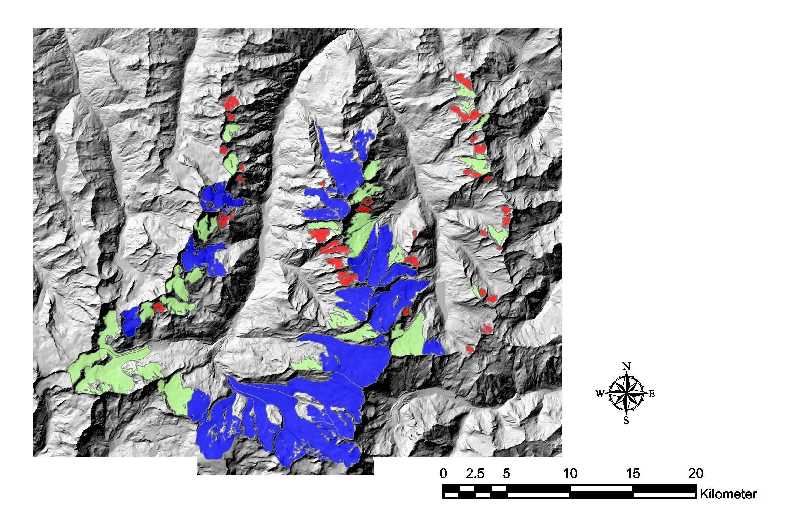GIS-based modelling of glacial sediment
balance
Zemp Michael, Kääb Andreas,
Hoelzle Martin and Haeberli Wilfried
Glaciology and Geomorphodynamics
Group, Department of Geography
University of Zurich, Switzerland
Abstract
In view
of ongoing atmospheric warming, there is concern as to whether retreating
glaciers uncover a rocky or sedimentary bed. Sedimentary beds are abundant
in high-mountain areas and represent - if exposed - a severe potential
for outbursts of periglacial lakes and debris flows. This paper assesses
the utilization of GIS to derive process relevant parameters of glacial
sediment balance from a Digital Elevation Model ("DEM"). The method was
automated, and tested on 84 Swiss Alpine glaciers. Essentially, this approach
may provide basis elements for the quantification of periglacial debris
production and the compiling of a global inventory of land ice masses within
the Glacier Land Ice Measurement from Space ("GLIMS") project.
Introduction
As a
consequence of ongoing atmospheric warming, most Alpine glaciers retreat.
Swiss Alpine glaciers lost about 27 % of surface area and about 30 % of
ice volume in the period of 1850 to 1973 (MAISCH et al., 1999a). As a consequence
increasing areas of former glacier beds become exposed. Characteristics
of such newly exposed glacier beds greatly influence sediment flux in meltwater
streams, the formation of potentially dangerous periglacial lakes and debris
flow activity on steep morainic slopes (HAEBERLI et al., 1997).
The question whether glaciers
erode into bedrock or build up thick sedimentary beds leads to the question
of the processes of glacial erosion and sedimentation and of glacial sediment
balance. These processes are complex and (since taking place at the glacier
bed) are difficult and expensive to be measured. Measurements of sediment
flux in meltwater streams by DREWERY (1986) show that the sediment balance
of alpine glaciers is dominated by the periglacial debris input, whereas
glacial erosion is less important.
This paper presents a GIS-based
approach to the glacial sediment balance of alpine glaciers.
Erosion-Sedimentation Index Ies
The
sediment balance of a glacierized mountain catchment, i.e. the ratio between
debris input from the surrounding rock walls and debris evacuation by the
meltwater stream, cannot be measured directly. Therefore, the main factors
influencing the governing processes have been organized by HAEBERLI (1986)
into an index ("Ies") of glacier erosion and sedimentation (Fig. 1), which
discriminates between glaciers eroding into bedrock and those building
up sedimentary beds:
where
a·C
represents
debris production in which a is a factor indicating whether
debris is furnished to the ablation area (1.0) as well as to the accumulation
area (0.5). C is the mean height of debris-providing cliffs (100
m). (P-b)·S·Jk reflects the transport capacity
of the meltwater stream where P is the annual precipitation (m),
b
is
the annual glacier mass balance (m), S
is the total surface area
of the glacier (km2), J is the inclination of the sub-/proglacial
meltwater stream and k is a constant from river hydraulics (1.6).
L
is
the glacier length (km). The dimension-less units in this ratio of factors
are chosen so that numbers around 1 result.
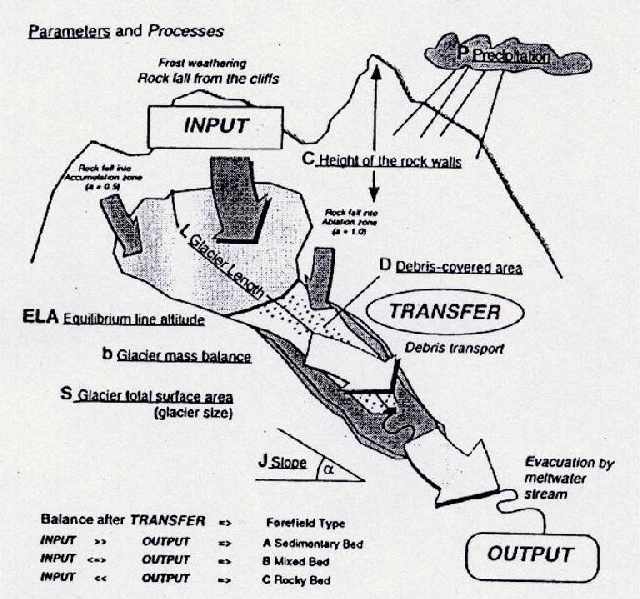
Fig. 1: Sheme
explaining the erosion-sedimentation index ("Ies"), the processes and parameters
involved.
The
Ies has been developed as a "rule of thumb" and allows a rough assessment
of glacial sediment balance. WENZEL (1992) applied this approach to investigate
glaciers in the Valais Alps, Switzerland. He used glacier inventory data,
maps, aerial photography and field observations to derive the needed Ies-parameters
for each glacier. To verify his approach he compared his results to the
debris characteristic found in the glacier forefields. MAISCH et al. (1999b)
tested the Ies-index with systematically classified glacier forefields
from the revised Swiss glacier inventory.
Parameter Extraction
Improvements in resolution and
quality of Digital Elevation Model ("DEM") allowed the conversion of the
Ies from a "rule of thumb" into a GIS-based approach of the glacial sediment
balance. Therefore, methods to extract the needed Ies-parameter from DEM
have been developed. The methods are based on a hierarchical system for
the extraction of geomorphometric parameters and objects presented
by SCHMIDT and DIKAU (1999) (Fig. 2). The system is based on the extraction
of primary geomorphometric parameters. In a second step these parameters
are analyzed to derive geomorphometric objects. These objects are the basis
of a hierarchical system consisting of object analysis and object aggregation
leading to representative geomorphometric parameters and geomophometric
objects of a higher scale.

Fig.
2: System of methods for the extraction of geomorphometric parameters
and objects (slightly modified after SCHMIDT and DIKAU, 1999).
For
the Ies-parameter extraction, a digital elevation model ("DEM25") with
a resolution of 25 meters and digitized glacier outlines and central flowlines
from the new Swiss glacier inventory SGI2000 (PAUL et al., 2002 and KÄÄB
et al., 2002) were used. Glacier outlines ("GLACIER1973") and central flowlines
("CFL1850") date from the year 1973. Fig. 3 shows the used data a.e. of
Rotblatt glacier #3.
The methods were developed
in ArcGIS 8.1 Desktop and Workstation.
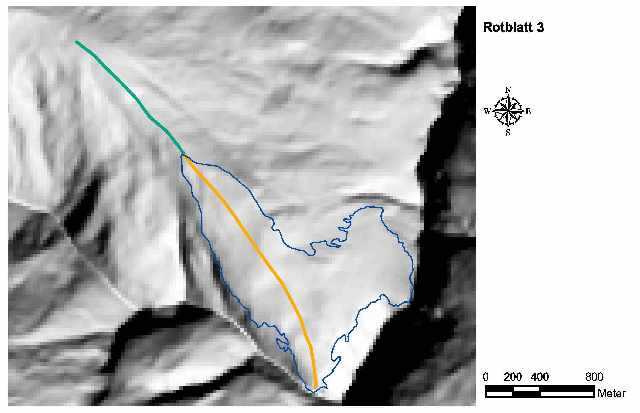
Fig. 3: Rotblatt glacier #3.
Glacier outline 1973 (blue), central flowline 1850 divided in CFLforefield1850
(green) and CFL1973 (orange). Hillshading derived from the DEM25 ©
Swiss Federal Office of Topography (BA024341).
The Ies-parameter were extracted
as followes:
-
Glacier surface area S and
glacier length L can be derived from the shape of GLACIER1973 and
CFL1850.
-
The slope of the meltwater stream
was derived by extracting the mean slope of the DEM25 along the CFL1850
in the glacier forefield and the same distance within the GLACIER1973.
-
For the extraction of rock walls,
slopes derived from DEM25 were compared to the rock wall signature in topographic
maps, scale 1:25'000 (from the Swiss Federal Office of Topography). It
can be shown that for high mountain area slopes steeper than 33° are
a good representation of rock walls. A rock fall modelling allows the selection
of all the rock walls that are responsible for the debris input of a glacier.
Therefore a critical angle of 30° (GERBER, 1994) between uppermost
rock-fall starting point and lowermost point of deposit zone is used in
combination with a cell-based hydrological flowpath-modelling (Fig. 4).
The mean height of debris-providing cliffs C can then be calculated
within the extracted rock walls (Fig.5).
-
To extract factor a and
annual precipitation P the Equilibrium Line Altitude ("ELA") is
used. The ELA is often estimated by an Accumulation Area Ration ("AAR")
of 0.67 (a.e. MAISCH et al., 1997) - for a steady-state glacier the accumulation
area can be roughly approximated as twice as large as the ablation area.
Thus, the ELA can be computed by extracting the glacier hypsography with
GLACIER1973 and DEM25.
-
Once having determined the glaciers
ELA, factor a is set by analyzing rock fall cells in the accumulation
and ablation area.
-
Annual precipitation P can
be roughly estimated by an empirical relationship between ELA and annual
precipitation.
The
presented methods are described in more detail and discussed in ZEMP (2002).
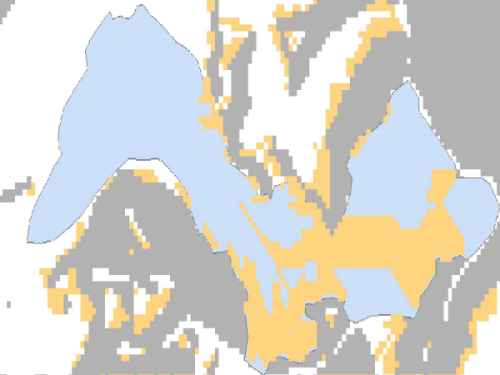
Fig. 4: Gruben glacier
with extracted rock wall cells in grey and potential rock fall cells in
orange.
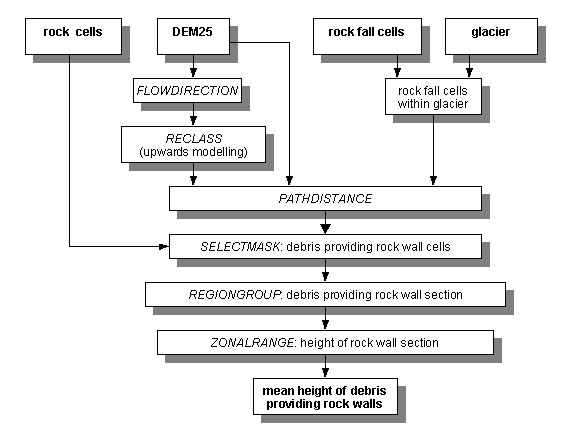
Fig. 5: Simplified
scheme explaining the extraction of a glacier's debris providing rock wall
height within the GRID module of ArcInfo Workstation.
Automation and Results
The
GIS-based parameter extraction was automated as AML-routine for ArcInfo
8.1 and tested with glaciers in the Valais Alps, Switzerland; the same
glaciers that have been manually investigated by WENZEL (1992). Using the
DEM25, GLACIER1973 and CFL1850 as input date, the AML-routine calculates
the Ies-parameter. Fig. 6 shows the resulting 84 indexed glaciers, classified
as rocky, sedimentary or mixed bed.
The used AML-routine is further
presented and discussed in ZEMP (2002).
Fig. 6: Indexed glaciers
in the Valais Alps, Switzerland. Rocky beds in blue, mixed beds in green
and sedimentary beds in red. Hillshading derived from the DEM25 ©
Swiss Federal Office of Topography (BA024341).
Comparison of the GIS-based Approach with WENZEL (1992)
From
the 84 investigated glaciers 64 glaciers could directly be compared with
the ones investigated by WENZEL (1992). For 20 glaciers WENZEL (1992) did
not use the same glacier outlines, so the corresponding glaciers could
not directly be compared. However, the results from the GIS-based approach
were compared with forefield classification (Fig. 7) and manually estimated
Ies-index from WENZEL (1992) (Fig. 8).
The comparison of the results
from the GIS-based approach with the forefield classification (Fig. 7)
shows an overall accuracy of 55.6%. For 32.4% of the investigated glaciers
there is a difference of 1 class. For 12 % of the glaciers the GIS-based
approach predicts the opposite of what can be found in the glacier forefield.
For the comparison of his manually indexed glaciers with the classified
forefields, WENZEL (1992) found an overall accuracy of 59.3 %. The comparison
of the indexed glacier with the forefield from 1850 can be problematic
due to the possibility of changing erosion-sedimentation characteristics
of a retreating glacier.
|
Forefield (WENZEL 1992)
|
|
|
1
|
2 |
3 |
Total |
Predicted
bed
(ZEMP 2002) |
1 |
8 |
2 |
1 |
11 |
| 2 |
7 |
10 |
5 |
22 |
| 3 |
7 |
6 |
18 |
31 |
|
22 |
18 |
24 |
64 |
|
| Correct in % |
36.4 |
55.6 |
75.0 |
55.6 |
| Difference of
1 class in % |
31.8 |
44.4 |
20.8 |
32.4 |
| Difference of
two classes in % |
31.8 |
0.0 |
4.2 |
12.0 |
| Total in % |
|
100.0 |
Fig. 7: Comparison of the GIS-based approach with the forefield
classification from WENZEL (1992). 1 = rocky bed, 2 = mixed bed, 3 = sedimentary
bed.
Comparing the indexed glaciers from the GIS-based approach with the
ones from the manual approach from WENZEL (1992) (as shown in Fig. 8) an
overall accuracy of 86.4 % was found; a difference of one class for 13.6
% and no glacier where the two approaches came to a totally different result.
|
Predicted bed (WENZEL 1992)
|
|
|
1
|
2 |
3 |
Total |
Predicted
bed
(ZEMP 2002) |
1 |
10 |
1 |
0 |
11 |
| 2 |
1 |
18 |
3 |
22 |
| 3 |
0 |
4 |
27 |
31 |
|
11 |
23 |
30 |
64 |
|
| Correct in % |
90.9 |
78.3 |
90.0 |
86.4 |
| Difference of
1 class in % |
9.1 |
21.7 |
10.0 |
13.6 |
| Difference of
two classes in % |
0.0 |
0.0 |
0.0 |
0.0 |
| Total in % |
|
100.0 |
Fig. 8: Comparison of the GIS-based approach with the manually
approach from WENZEL (1992). 1 = rocky bed, 2 = mixed bed, 3 = sedimentary
bed.
Conclusions and Perspectives
GIS-based methods to
extract the needed Ies-parameter from DEM have been developed and successfully
automated with an AML-routine for ArcInfo Workstation. The results lead
to the following conclusions:
-
The Ies allows for a rough assessment of the glacial sediment balance.
-
In order to improve the predictability of glacier-bed characteristics,
a better understanding of the periglacial debris production is necessary.
-
The high overall accuracy of the comparison of the fully automated GIS-based
approach with the manually glacier-by-glacier investigation from WENZEL
(1992) shows the potential of GIS-based modelling with DEM in geomorphodynamics.
The presented GIS-based approach may provide basis elements for:
-
a better understanding of glacial sediment transport and budget by comparing
model results with actual expression in nature
-
the quantification of periglacial debris production
-
the Glacier Land Ice Measurement from Space ("GLIMS") project which is
compiling a global inventory of land ice masses within the framework of
global glacier monitoring (HAEBERLI et al., 2000)
-
the search of potentially dangerous sediment beds of retreating glaciers
There is a large potential for the combination of GIS-based modelling with
DEM and methods of remote sensing in geomorphodynamics and natural hazard
analysis in high mountain areas.
Acknowledgments
The presented
paper is financially supported by the Swiss Glaciological Commission and
the Swiss Academy of Sciences. Sincere thanks are given to Frank Paul and
Andreas Wipf for their hard work digitizing the glacier outlines, Max Maisch
for putting the data of Swiss Glacier Inventory to the author's disposal
and Regula Frauenfelder for the fruitful discussions on rock wall weathering.
Special thanks go to Esri Switzerland for supporting this study with access
to its software and its technical knowledge.
References
DIKAU, R., SAURER, H. (1999): GIS for earth surface systems: analysis and
modelling of the natural environment. Stuttgart, S. 153 - 173.
DREWERY,D. (1986): Glacial geologic processes. Ed. Arnold, London.
GERBER, W. (1994): Beurteilung des Prozesses Steinschlag. Schweiz. Forstl.
Arbeitsgruppe Naturgefahren (FAN), Kursunterlagen Herbstkurs vom 20. -
22. Oktober 1994, Poschiavo.
HAEBERLI, W. (1986): Factors influencing the distribution of rocky and
sedimentary glacier beds. In: Hydraulic effects at the glacier bed and
related phenomena. Mitteilung der Versuchsanstalt für Wasserbau, Hydrologie
und Glaziologie, Nr. 90, S. 48f. Zürich.
HAEBERLI, W., WEGMANN, M. and VONDER MÜHLL, D. (1997): Slope stability
problems related to glacier shrinkage and permafrost degradation in the
Alps. Eclogae Geol. Helv., 90, 407 - 414.
HAEBERLI, W., CIHLAR, J. and BARRY, R. (2000): Glacier monitoring within
the Global Climate Observing System. Annals of Glaciology, 31, 241 - 246.
KÄÄB, A., PAUL, F., MAISCH, M., HOELZLE, M. and HAEBERLI,
W. (2002): The new remote sensing derived Swiss glacier inventory: II.
Results. Annals of Glaciology, 34, in press.
MAISCH, M., WIPF, A., DENNELER, B., BATTAGLIA, J., BENZ, C. (1999a):
Die Gletscher der Schweizer Alpen, Gletscherhochstand 1850 - Aktuelle Vergletscherung
- Gletscherschwund-Szenarien. NFP31 Schlussbericht, vdf, Zürich.
MAISCH, M., HAEBERLI, W., HOELZLE, M., WENZEL, J. (1999b): Occurrence
of rocky and sedimentary glacier beds in the Swiss Alps as estimated form
glacier-inventory data. Annals of Glaciology 28.
PAUL, F., KÄÄB, A., MAISCH, M., KELLENBERGER, T. W. and HAEBERLI,
W. (2002): The new remote sensing derived Swiss glacier inventory: I. Methods.
Annals of Glaciology, 34, in press.
SCHMIDT, J. and DIKAU, R. (1999): Extracting geomorphometric attributes
and objects from digital elevation models - semantics, methods, future
needs. In: DIKAU, R., SAURER, H. (1999).
WENZEL, J. (1992): Erosion und Sedimentation von Gebirgsgletschern.
Diplomarbeit, Universität Trier.
ZEMP, M. (2002): GIS-basierte Modellierung der glazialen Sedimentbilanz.
Diplomarbeit, Geographisches Institut der Universität Zürich.
Author Information
|
|
|
Physical Geography Division
Departement of Geography
University of Zurich-Irchel
Winterthurerstr. 190
CH-8057 Zurich
Switzerland |





